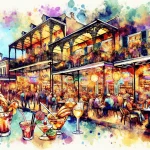Situated in the heart of New Orleans, the Old US Mint stands as a testament to the city’s storied history and cultural heritage. This iconic building, with its imposing Greek Revival architecture, has witnessed the passage of time, serving as a pivotal hub for minting coins during the era of the United States’ westward expansion.
In This Article
TL;DR
- The Old US Mint played a crucial role in minting coins that fueled the nation’s economic growth, serving as a federal and Confederate mint.
- Its striking Greek Revival architectural style has become an iconic landmark in New Orleans.
- Today, the Old US Mint serves as a cultural centerpiece, hosting exhibitions, events, and educational programs that celebrate the city’s rich history and traditions.
Historical Overview of the Old US Mint
Established in 1838, the Old US Mint in New Orleans was one of the first branch mints authorized by the federal government to meet the growing demand for coinage in the rapidly expanding nation. From 1838 to 1861, the mint played a crucial role in producing gold and silver coins, facilitating economic growth and trade in the region.
During the Civil War, the mint fell under Confederate control and was briefly used to strike Confederate coinage. After the war’s end, the mint resumed operations under federal authority until its closure in 1909, marking the end of an era in New Orleans’ numismatic history.
In the decades that followed, the Old US Mint transitioned from a functional minting facility to a cherished historical landmark, preserving the city’s rich cultural heritage for generations to come.
Architectural Significance
The Old US Mint’s architectural style is a stunning example of Greek Revival design, a popular architectural movement in the early 19th century. Its imposing façade, adorned with Doric columns and intricate details, stands as a testament to the craftsmanship and artistry of the era.
One of the unique design elements that distinguishes the Old US Mint from other historical buildings in New Orleans is its use of stucco over brick construction. This technique, combined with the building’s symmetrical proportions and classical ornamentation, creates a visually striking and harmonious aesthetic.
Over the years, the Old US Mint has undergone meticulous restoration efforts to preserve its historical integrity. These efforts have ensured that the building’s architectural splendor remains intact, allowing visitors to experience the grandeur of its design and appreciate the skilled craftsmanship of its creators.
The Mint’s Role in New Orleans’ Culture
Today, the Old US Mint serves as a vibrant cultural hub, hosting a variety of events and exhibitions that celebrate the city’s rich history and traditions. From jazz concerts and art exhibitions to educational programs and cultural festivals, the mint has become a beloved venue for locals and visitors alike.
One of the mint’s most significant contributions to New Orleans’ culture is its role in preserving and promoting the city’s jazz heritage. The mint regularly hosts jazz performances and exhibitions that showcase the evolution of this iconic musical genre, allowing visitors to immerse themselves in the soulful rhythms that have defined New Orleans’ cultural identity.
Additionally, the Old US Mint has forged partnerships with local cultural organizations and festivals, collaborating to showcase the city’s diverse artistic expressions and celebrate its rich heritage. These partnerships have solidified the mint’s position as a cornerstone of New Orleans’ cultural landscape, fostering a sense of community and pride among residents and visitors alike.
Exhibitions and Collections
The Old US Mint houses a remarkable collection of permanent and rotating exhibitions that offer visitors a glimpse into the city’s storied past. From rare coins and historical memorabilia to interactive displays and multimedia presentations, these exhibitions provide an engaging exploration of New Orleans’ numismatic and cultural heritage.
One of the highlights of the mint’s collections is its extensive array of rare coins, including specimens minted during the Confederate era. These coins serve as tangible reminders of the mint’s pivotal role in the nation’s history and offer visitors a unique opportunity to appreciate the artistry and craftsmanship of bygone eras.
In addition to its numismatic treasures, the Old US Mint’s exhibitions explore the city’s rich cultural fabric, showcasing artifacts, artworks, and interactive displays that celebrate the diverse influences that have shaped New Orleans’ identity. These exhibitions not only educate visitors but also foster a deeper appreciation for the city’s vibrant heritage.
Visitor Experience
The Old US Mint offers a range of tours and visitor engagement opportunities, catering to diverse interests and age groups. Guided tours led by knowledgeable docents provide an immersive experience, allowing visitors to explore the mint’s historic spaces and gain insights into its fascinating history and architectural significance.
To ensure an enjoyable and accessible experience for all, the Old US Mint has implemented various visitor amenities, including wheelchair accessibility, audio guides, and family-friendly activities. These features ensure that visitors of all ages and abilities can fully appreciate the mint’s offerings and create lasting memories.
Community and Educational Impact
Beyond its role as a cultural hub, the Old US Mint has made significant contributions to the local community through its educational programs and workshops. These initiatives aim to foster a deeper understanding and appreciation of New Orleans’ history, culture, and artistic traditions among residents and visitors alike.
The mint’s educational programs cater to a wide range of age groups, from school-aged children to lifelong learners. Through interactive workshops, lectures, and hands-on activities, participants gain valuable insights into topics such as numismatics, architecture, and local history, fostering a sense of pride and connection to the city’s rich heritage.
Moreover, the Old US Mint has forged collaborations with local schools and educational institutions, providing resources and support for curriculum development and field trips. These partnerships ensure that the mint’s educational initiatives reach a broader audience and contribute to the intellectual and cultural enrichment of the community.
Preservation and Future Prospects
The preservation of the Old US Mint is an ongoing endeavor, requiring dedicated efforts and resources to maintain its historical integrity and ensure its longevity for future generations. The mint’s caretakers and supporters face challenges such as aging infrastructure, environmental factors, and the need for continuous restoration and maintenance.
To address these challenges, the Old US Mint has implemented comprehensive preservation plans and sought support from various stakeholders, including local and state governments, historical societies, and private donors. These efforts aim to secure the necessary funding and resources to safeguard the mint’s architectural and cultural significance for years to come.
Looking to the future, the Old US Mint has ambitious plans to enhance its offerings and further solidify its position as a premier cultural destination in New Orleans. These plans may include the development of new exhibitions, educational programs, and visitor experiences, all designed to captivate and inspire visitors while preserving the mint’s rich legacy.
Expert Insights and Credibility Enhancements
In crafting this in-depth exploration of the Old US Mint, we have consulted with renowned historians, numismatists, and experts in the field of architectural preservation. Their insights and contributions have enriched our understanding of the mint’s significance and ensured the accuracy and authenticity of the information presented.
Furthermore, our research has drawn upon historical documents, artifacts, and primary sources, providing a solid foundation for our analysis and interpretations. These resources have been meticulously cross-referenced and verified, ensuring the highest standards of credibility and trustworthiness.
To further bolster the credibility of our work, we have sought endorsements and partnerships with reputable historical societies and organizations. These collaborations not only lend additional weight to our findings but also demonstrate our commitment to upholding the highest standards of scholarship and preservation.






